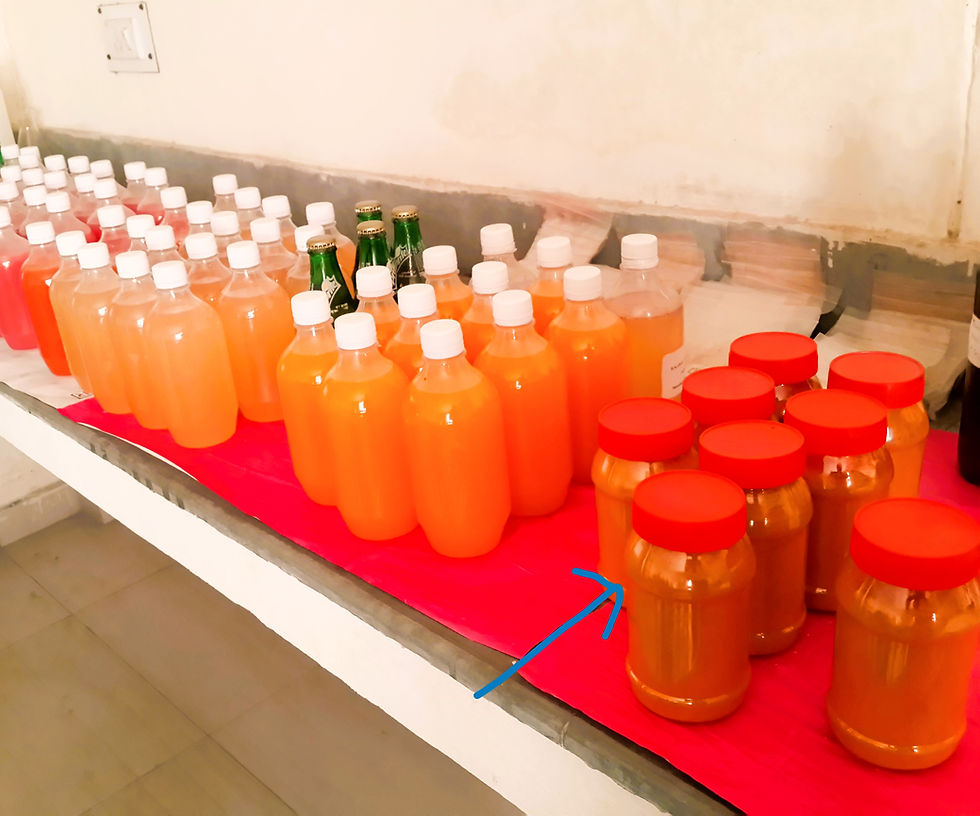Marmalade
The English word ‘marmalade’ is taken from French word ‘marmelade’ that is came from the Portuguese ‘marmelada’ meaning quince preserve and the ‘marmelada’ word has been derived from Portuguese ‘marmelos’ for quince (Cydonia oblonga Mill) fruits. The marmalade was initially used for a preserve made from quince fruits. The Romans learned from the Greek about using the quinces by cooking fruits with honey which set after cooling because quinces were astringent in taste and could not be used without honey. Latter on quince fruits were replaced by citrus fruits in marmalade processing. The marmalade is made from pectin rich extract of citrus fruits cooking with sugar and containing the pieces of citrus peel. The limes, lemons, grapefruits, mandarins, sweet oranges and other citrus fruits may be used for marmalade. Two or more types of citrus fruits are also used in marmalade preparation. The bitter taste of citrus peel which extracts into marmalade is desirable. The best quality marmalade is prepared from pectin rich Seville oranges (Citrus aurantium) grown around Seville city of the Spain. Britain imports Seville oranges from Spain especially for marmalade. The term marmalade is generally associated with the product made from the citrus fruits in which shreds of fruit peel is present as suspended material. The conditions require for jam is similar to jelly but the pectin and acid content of marmalade should be kept slightly higher than that of jelly. According of Food Safety and Standard of India (FSSAI) “Marmalades means a product prepared by boiling sound fruits with peel, pulp and Juice, with or without water, added nutritive sweeteners and concentrating to such a consistency that gelatinization takes place on cooling of the product. It shall not be syrupy, sticky or gummy and shall be clear and transparent”. The product marmalade can be classified into two groups depending upon physical appearance:
Jelly Marmalade
If the prepared shreds of Malta peel are incorporated into jelly of citrus fruits the product is termed jelly marmalade. The following combinations of the different citrus fruits are commonly used for making quality jelly marmalade:
Malta or sweet orange (Citrus sinensis) and khatta or bitter orange (C. aurantium) in the ratio of 2:1 by weight with shreds of Malta peel.
Mandarin (C. reticulata) and khatta in the ratio of 2:1 by weight with shreds of Malta peel.
Malta or sweet orange and galgal or Rangpur lime (Citrus limonia) in the ratio of 2:1 by weight with shreds of Malta peel.
FSSAI Standard of Marmalade
T.S.S.: Not less than 65%
Fruit Content (Excluding Peel): Not less than 45%
Peel in Suspension: Not less than 5%
Synthetic Food Color: 200 ppm maximum
Preservative (Maximum): Benzoic Acid 200 ppm or SO2 40 ppm or Sorbic Acid 500 ppm
Artificial Sweetener & Polyols (maximum): Aspartame 1000 ppm or Sorbitol 30%
Moulds Count: Positive is not more than 40% of field examined, not more than 125 per 1/ 60 c.m.m.
Preparation Technique of Marmalade
Pectin extraction
The outer yellow portion of the citrus fruit peel is called flavedo which contains coloring substances and volatile oils while inner white portion of the peel is called albedo contains pectin. The flavedo is peeled off leaving the albedo on the fruits. The peeled fruits carrying albedo are crushed or cut into slices of 0.3 to 0.45 cm thickness to facilitate the pectin extraction. Then 2 to 3 times water is added to slices and boiled for about half an hour. The boiled material is passed through muslin cloth or jelly bag to get pectin extract which is cleared by leaving overnight for sedimentation followed by siphoning off. The cleared extract is used in marmalade making.
Preparation of shreds from peel
The peels are cut into shreds of 1.9 to 2.5 cm long and 0.8×0.12 cm thick size and are boiled for 10-15 minutes in several changes of water. It softens the shreds and removes bitter principles from the shreds. The softened shreds are put into water and taken out just before adding into marmalade.
Marmalade Preparation Flow Chart
Selection of citrus fruits
↓
Peeling of flavedo
↓
Slicing or crushing of peeled fruits
↓
Boiling for pectin extraction with
2-3 times water for about 30 minutes
↓
Straining the extract
through muslin cloth
↓
Test for pectin content
↓
Addition of sugar
↓
Cooking up to 103°C
↓
Addition of prepared shreds
(@ 62g/kg extract)
↓
Cooking till end point
(Similar to Jelly)
↓
Cooling (82-88°C) to prevent
the floating of shreds to surface
↓
Addition of flavour
(if need)
↓
Hot filling into bottles
↓
Paraffin waxing
↓
Capping and labeling
↓
Storage
Jam marmalade
In the preparation of Jam marmalade fruit pulp is used in place of clear pectin extract and pectin test is also not done. Rest method of preparation is similar to jelly marmalade. The sliced citrus fruits are boiled and passed through pulper to convert into pulp. The shreds of peel are prepared as in case of jelly marmalade. The pulp and sugar are cooked and peel shreds are added when end point reached at which jam marmalade contains not less than 65 per cent TSS, the jam marmalade is filled into bottles, sealed and stored at cool and dry place.


Comments